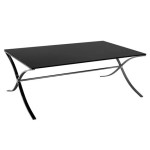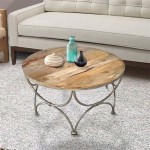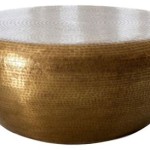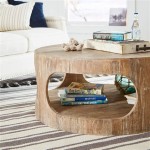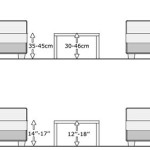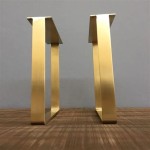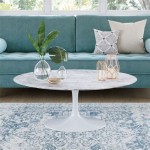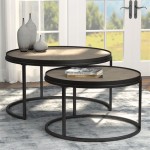How To Choose The Right Ornate Coffee Table Legs For Metal
Selecting the appropriate ornate coffee table legs for a metal coffee table base involves a careful consideration of several factors. The goal is to achieve a harmonious balance between the visual appeal of the legs and the overall design, stability, and functionality of the coffee table. These factors include the style of the metal base, the desired aesthetic, the height and weight requirements, and the intended use of the coffee table.
The term "ornate" encompasses a wide spectrum of decorative styles. Identifying the specific type of ornamentation that complements the metal base is paramount. This article will guide you through the key considerations to ensure a successful integration of ornate legs with a metal coffee table project.
Matching Ornamentation Styles to Metal Base Designs
The design of the metal coffee table base dictates the direction for choosing ornate legs. A minimalist, clean-lined metal base calls for a different style of ornamentation than a base with intricate metalwork. The principle is to create a cohesive visual language, where the legs enhance and complement the existing metal structure, not compete with it.
Consider the metal finish of the base. Polished chrome or brushed stainless steel often pairs well with modern or Art Deco-inspired ornate legs, featuring geometric patterns and clean lines. Blackened or wrought iron bases, on the other hand, can accommodate more rustic or Victorian-style ornamentation, such as floral motifs, scrolls, and cabriole legs. The color and texture of the metal significantly influence the choice of leg style and finish.
Specifically, examine the metal base for repeating patterns or motifs. If the base features scrolls, look for ornate legs that incorporate similar scrollwork. If the base has a geometric design, consider legs with geometric carvings or inlays. The aim is to repeat elements of the base’s design in the legs, creating a unified and aesthetically pleasing whole.
A critical error would be to pair highly ornate, Victorian-style legs with a sleek, modern metal base. This mismatch creates visual dissonance and can detract from the overall appeal of the coffee table. Therefore, careful attention to the stylistic relationship between the base and the legs is essential.
Evaluating Material Compatibility and Durability
While the primary focus is on aesthetic compatibility, material compatibility, and durability are equally important. Ornate coffee table legs are typically crafted from wood, metal, resin, or a combination of these materials. Each material offers different properties regarding strength, weight, and resistance to wear and tear.
If considering wooden legs, hardwood varieties such as oak, maple, or walnut are ideal. These woods are known for their strength and durability, ensuring they can support the weight of the coffee table and its contents. The wood can be stained or painted to match or complement the metal base. Ensure the wood is properly sealed to prevent moisture damage and warping, especially if the coffee table is placed in a high-humidity environment.
Metal legs, particularly those made from steel or iron, offer exceptional strength and stability. These can be particularly suitable for heavier coffee tables or those intended for frequent use. Metal legs can be powder-coated to provide a durable and scratch-resistant finish that matches the metal base. The welding or joining methods used in metal legs should be inspected for quality to ensure long-term durability.
Resin legs offer a lightweight and cost-effective alternative. However, it's crucial to select high-quality resin that is resistant to chipping and cracking. Resin legs can be molded into intricate designs, making them a versatile option for replicating various ornamentation styles. However, be aware of their potential limitations in terms of load-bearing capacity compared to wood or metal.
The chosen material must be capable of withstanding the intended use of the coffee table. A coffee table used primarily for decorative purposes may require less robust legs than one frequently used to support books, drinks, or other heavy items.
Determining Appropriate Leg Height and Weight Capacity
The height and weight capacity of the ornate coffee table legs are crucial considerations for both aesthetic and functional reasons. The height of the legs determines the overall height of the coffee table, which should correspond to the height of the surrounding seating. The weight capacity, conversely, ensures the table can safely support its intended load.
Standard coffee tables typically range from 16 to 18 inches in height. However, this can vary depending on the style and intended use. For example, a coffee table used primarily for serving drinks and snacks might be slightly taller than one used primarily for decorative purposes. Measure the height of the surrounding sofas and chairs to determine the optimal height for the coffee table. The goal is to create a comfortable and accessible surface for users.
Consider the visual proportions of the legs relative to the tabletop and metal base. Legs that are too short can make the table appear squat and unbalanced, while legs that are too tall can make it seem unstable. A general rule of thumb is to aim for a leg height that provides a visually pleasing balance between the tabletop and the floor.
The weight capacity of the legs must be sufficient to support the weight of the tabletop, the metal base, and any items placed on the table. Overestimating the weight capacity is preferable to underestimating it, as this ensures the table remains stable and safe. Check the manufacturer’s specifications for the maximum weight capacity of the chosen legs. If this information is not readily available, inquire directly with the supplier.
For larger or heavier coffee tables, consider using more than four legs. Adding a fifth or sixth leg, particularly in the center of the table, can provide additional support and stability. This is especially important if the tabletop is made of a heavy material such as marble or granite.
Failure to select legs with an adequate weight capacity can lead to structural failure, resulting in damage to the coffee table and potential injury. Therefore, carefully assessing the weight requirements is an essential step in the selection process.
Assessing the Complexity of Installation and Attachment Methods
The method of attaching the ornate legs to the metal coffee table base is a practical consideration that influences the overall project. The attachment method should be secure, reliable, and relatively straightforward, especially for DIY projects. Common attachment methods include screwing, bolting, welding, and using adhesive.
Screwing is a common method, particularly for wooden legs. The legs are typically equipped with pre-drilled holes, which align with corresponding holes in the metal base. Screws are then used to fasten the legs securely to the base. Ensure that the screws are of the appropriate length and gauge to provide a strong and stable connection. Consider using wood screws with a coarse thread for better grip in wooden legs.
Bolting provides a more robust attachment method, particularly for heavier coffee tables or those subject to frequent use. Bolts typically pass through holes in both the legs and the metal base, and are secured with nuts and washers. This creates a very strong and stable connection. Ensure that the bolts are of the appropriate size and grade to withstand the intended load. Consider using lock washers to prevent the nuts from loosening over time.
Welding is a permanent attachment method that requires specialized equipment and skills. This method is typically used for metal legs, where the legs are welded directly to the metal base. Welding provides an extremely strong and durable connection. However, it is not easily reversible and requires careful planning and execution.
Adhesive can be used as a supplementary attachment method, particularly in conjunction with screws or bolts. Construction adhesive can provide additional bonding strength and help to prevent the legs from shifting or loosening over time. However, adhesive alone is typically not sufficient to provide a secure and reliable attachment.
Before commencing the installation, carefully review the manufacturer’s instructions for the chosen legs. Ensure that you have the necessary tools and materials on hand. If you are unsure about any aspect of the installation process, seek assistance from a qualified professional.
Considering the Finish and Detailing of the Legs
The finish and detailing of the ornate coffee table legs are essential for achieving the desired aesthetic and ensuring the longevity of the piece. The finish should complement the metal base and provide protection against wear, tear, and environmental factors. Detailing, such as carvings, inlays, or accents, can enhance the visual appeal and add character to the coffee table.
For wooden legs, common finishes include staining, painting, and clear coating. Staining enhances the natural grain of the wood and can be used to create a variety of different looks, from rustic to modern. Painting provides a solid color finish and can be used to match or complement the metal base. Clear coating protects the wood from moisture, scratches, and UV damage.
Metal legs can be finished with powder coating, plating, or painting. Powder coating provides a durable and scratch-resistant finish that is available in a wide range of colors. Plating, such as chrome or brass plating, provides a decorative and corrosion-resistant finish. Painting can be used to match or complement the metal base.
Consider the level of detail desired in the legs. Intricate carvings, such as floral motifs or geometric patterns, can add a touch of elegance and sophistication. Inlays, such as mother-of-pearl or metal accents, can create a focal point and enhance the visual appeal. However, be mindful of the overall design aesthetic and avoid excessive detailing that could detract from the metal base.
The finish should be appropriate for the intended use of the coffee table. A coffee table used primarily for decorative purposes may require a more delicate finish than one frequently used to support drinks and snacks. Ensure that the finish is durable and easy to clean.
Ultimately, selecting the right ornate coffee table legs for a metal base requires a holistic understanding of style, material, function, and installation. Careful consideration of these factors will result in a coffee table that is both aesthetically pleasing and structurally sound.

Metal Coffee Table Legs Flowyline Design

Metal Coffee Table Legs Flowyline Design

Essential Guide To Table Leg Styles Choosing The Perfect Match For Yo Modern Bungalow Furniture And Design

Guide On Diy Live Edge Table With Metal Legs Flowyline Design

28 Types Of Furniture Legs Antique Modern Styles Mallery Hall

Metal Coffee Table Legs Flowyline Design

The Basics Of Coffee Table Styling Shades Blue Interiors

The Easiest Way To Update Furniture Rural Legend

Metal Coffee Table Legs Flowyline Design

Center Table Buy Wooden Tables In At Best 200 Latest Designs 2024 Page 2
Related Posts

